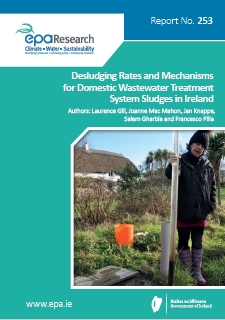Authors: Laurence Gill, Joanne Mac Mahon, Jan Knappe, Salem Gharbia and Francesco Pilla
Summary: This study has produced a set of guidelines for owners of septic tanks and packaged treatment systems to help to address the lack of understanding among homeowners of how their domestic wastewater treatment systems operate and to encourage responsible operation and maintenance.

The domestic wastewater of approximately one-third of the population in Ireland (489,069 dwellings) is treated on site by domestic wastewater treatment systems (DWWTSs), of which approximately 90% are septic tanks. The recent introduction of the National Inspection Plan (under the Water Services (Amendment) Act, 2012) means that records now need to be kept to prove that tanks have been desludged at the recommended frequency. This study has identified major gaps in capacity for both the transport of DWWTS sludge and treatment of sludge at wastewater treatment facilities. Current levels of collection and treatment are between 10% and 18% of the expected load if all DWWTS were to be desludged every 3 to 5 years.
This level of DWWTS sludge collection indicates that most septic tanks and packaged treatment systems in Ireland are rarely emptied and thus may pose both health and environmental risks. Particular areas of the country are likely to be under more pressure than others due to a current lack of facilities to receive and treat the sludge. These areas have been identified in western counties for the most part. Therefore, further analysis of wastewater treatment services in under-serviced areas is required.
Field studies to measure the rate of sludge accumulation, as well as a comprehensive review of international research in sludge accumulation and desludging frequency, have identified that a desludging interval of 3 years is suitable for septic tank systems bigger than 3.5 m3. Annual desludging has been found to be too frequent and can negatively disrupt the biological processes that develop within septic tanks, resulting in less than optimal decomposition of solids. The maximum interval between desludging for any tank should not exceed 5 years to avoid possible contamination of effluent with solids.
Rates of accumulation should be monitored annually for all tanks under 3.5 m3 and for older systems, which may be in a poor state of repair or undersized for current use, to determine bespoke appropriate desludging frequencies for these systems. Packaged treatment systems must be desludged at least annually and more frequently where recommended by the manufacturer. Current figures for collection of DWWTS sludge indicate that septic tanks and packaged treatment systems are for the most part neglected and incentives are needed to mobilise homeowners to desludge systems on a regular basis, not just when problems arise.
There is an urgent need to address the lack of understanding among homeowners of how their DWWTSs operate. This study has produced a set of guidelines for owners of septic tanks and packaged treatment systems to help to address this knowledge gap and encourage responsible operation and maintenance of DWWTSs.
In addition, messaging in other key areas could help to motivate homeowners to change operation and maintenance habits. These include communicating (1) their legal responsibilities not to pollute; (2) the health and environmental benefits of correct operation and maintenance; and (3) the economic benefits of carrying out regular desludging rather than expensive repair works. In addition, local coordination of regular desludging through organisations such as the National Federation of Group Water Schemes could mobilise homeowners more effectively and result in more economic desludging costs. A pilot project is currently running with this organisation in this regard. In terms of the effects of increased sludge loads on existing infrastructure, engagement with private desludging contractors, private waste facilities with permits to handle DWWTS sludge, and Irish Water is essential to properly address the need for increased capacity in terms of both the transport and treatment of DWWTS sludge.
https://www.epa.ie/media/epa-2020/publications/research/Research_253_thumnail[1].jpg